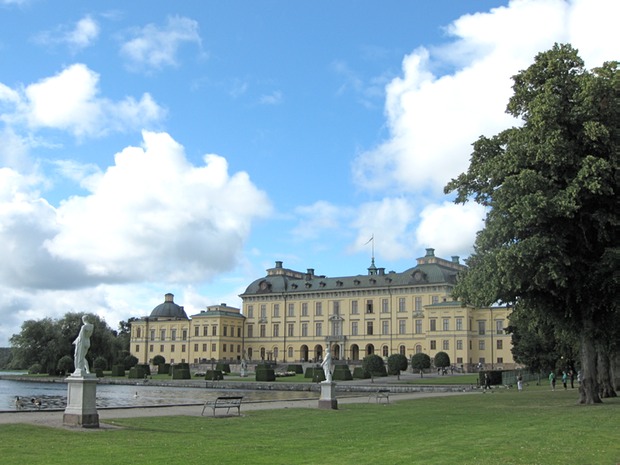We stopped on the outskirts of Stockholm for two nights in a crowded little campground (“crowded” means we tried to put down our awning to keep out the hot sun, but it hung over the narrow paved road by about 3 feet so we put it right back up again--no British “3 meters between caravans” in Sweden, thank you).
We picked this spot because we wanted to visit the Drottningholm palace and the Royal Theatre, which were within walking distance of the campground. It proved to be almost an hour’s walk, but a nice one through the forest and around a lake. The palace is the actual residence of the current king and queen, but much of it is open to the public just the same. Its vast grounds were inspired by Versailles, so it was quite spectacular.

But the real charm was the Royal Theatre. It is 250 years old and had been used regularly for about 100 years until the death of the king who had been its biggest patron. The theatre was then closed down, forgotten for years, and rediscovered only in 1920.
Nearly all of it is still in its original, unrestored condition, including painted scenery hundreds of years old. We were able to take a tour but were not allowed to take photographs. The most interesting fact is that scenery onstage can be completely shifted within seconds--and in full view of the audience--by a team of stagehands under the stage. (They accomplish this by turning a large wooden drum, around which ropes, connected to scenic trolleys, wrap and unwrap [got that? any questions? yes, this will be on the test.]) The whole thing was worth the walk . . . but we took the bus back to the campground anyway.
After Drottningholm, we went to our reserved camping place in the city of Stockholm. Getting to it meant going across a narrow concrete bridge with the GPS (in red) telling us we were a truck and what did we think we were doing, using this bridge? But we could see 60 motorhomes already on the other side, so we went anyway. This campground proved to be another gravel parking lot with motorhomes just lined up in rows. The facilities were OK, except that we had no WiFi for four days. But the bus and subway connections to get to the city center only two miles from us were only a short walk away (when it comes to campground facilities, convenience counts for a lot more than luxury with us).
According to a brochure we saw, Stockholm has 84 museums; it also has wonderful little--and big--shopping streets. It was a very busy place, and the good weather brought out people by the thousands. Once again we bought the Tourist Card for discounts and free admissions, and immediately set out to get our money’s worth. We visited three or four museums every day, took a boat tour and had guided tours of the National Theatre and the Opera House.
But the winner was the Vasa Museum. The Vasa was a huge warship built in 1628 and fitted out with 100 or so cannons. On the day it was launched, amid much celebration, with His Majesty the King looking on proudly, the wind filled its sails . . . it listed to one side . . . water poured into the open cannon port holes . . . and it sank to the bottom of the harbor: all this within about 20 minutes.
It stayed on the bottom for 333 years, until 1961, when it was found by divers and the project to raise it began. This work took two years, but now it is preserved and in a museum, along with all the artifacts that were brought up with it (including several skeletons). Everything but the food, fabrics and some of the wood had survived: tools, household goods, weapons, even some leather shoes. The museum’s low lighting made for poor photographs, but it was an amazing sight.

Susan has developed some stomach problems, but they haven’t really slowed us down much. Tomorrow the ferry to Finland will be a time to relax a little.
